SKODA FABIA 2003 1.G / 6Y Owner's Manual
Manufacturer: SKODA, Model Year: 2003, Model line: FABIA, Model: SKODA FABIA 2003 1.G / 6YPages: 233, PDF Size: 32.04 MB
Page 171 of 233
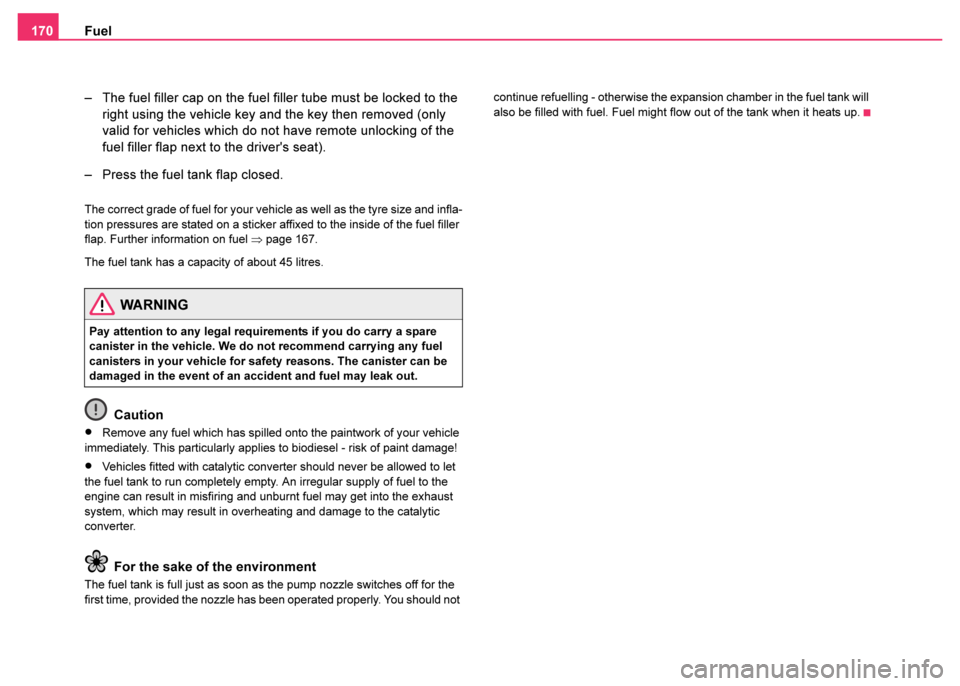
Fuel
170
– The fuel filler cap on the fuel filler tube must be locked to the right using the vehicle key and the key then removed (only
valid for vehicles which do not have remote unlocking of the
fuel filler flap next to the driver's seat).
– Press the fuel tank flap closed.
The correct grade of fuel for your vehicle as well as the tyre size and infla-
tion pressures are stated on a sticker affixed to the inside of the fuel filler
flap. Further information on fuel ⇒page 167.
The fuel tank has a capacity of about 45 litres.
Caution
•Remove any fuel which has spilled onto the paintwork of your vehicle
immediately. This particularly applies to biodiesel - risk of paint damage!
•Vehicles fitted with catalytic converter should never be allowed to let
the fuel tank to run completely empty. An irregular supply of fuel to the
engine can result in misfiring and unburnt fuel may get into the exhaust
system, which may result in overheating and damage to the catalytic
converter.
For the sake of the environment
The fuel tank is full just as soon as the pump nozzle switches off for the
first time, provided the nozzle has been operated properly. You should not continue refuelling - otherwise the expansion chamber in the fuel tank will
also be filled with fuel. Fuel might flow out of the tank when it heats up.
WARNING
Pay attention to any legal requirements if you do carry a spare
canister in the vehicle. We do not recommend carrying any fuel
canisters in your vehicle for safety reasons. The canister can be
damaged in the event of an accident and fuel may leak out.
Page 172 of 233
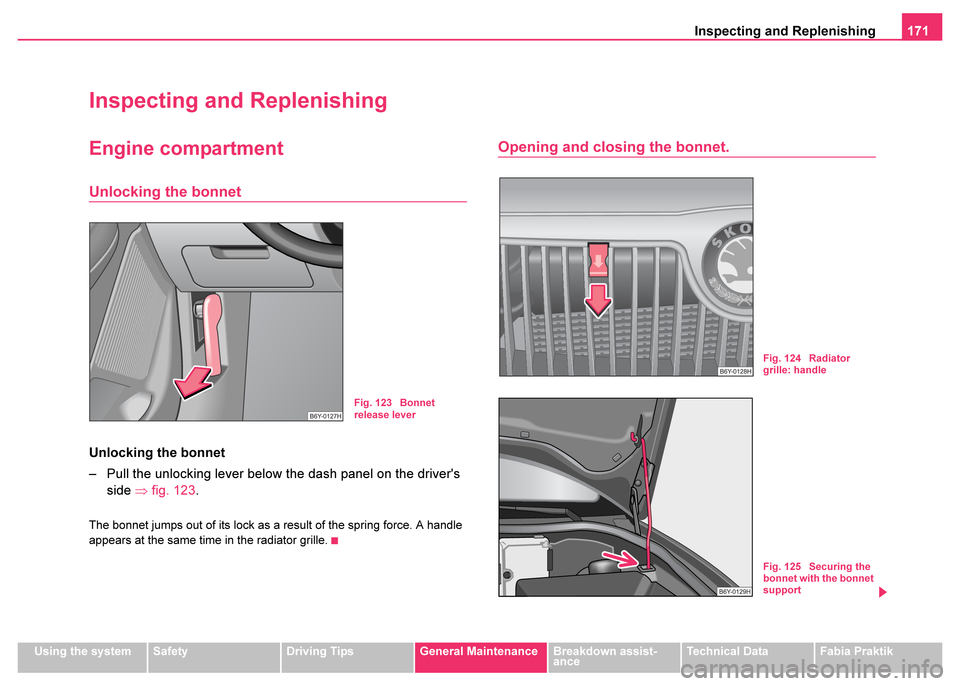
Inspecting and Replenishing171
Using the systemSafetyDriving TipsGeneral MaintenanceBreakdown assist-
anceTechnical DataFabia Praktik
Inspecting and Replenishing
Engine compartment
Unlocking the bonnet
Unlocking the bonnet
– Pull the unlocking lever below the dash panel on the driver's
side ⇒fig. 123 .
The bonnet jumps out of its lock as a result of the spring force. A handle
appears at the same time in the radiator grille.
Opening and closing the bonnet.
Fig. 123 Bonnet
release lever
Fig. 124 Radiator
grille: handle
Fig. 125 Securing the
bonnet with the bonnet
support
Page 173 of 233
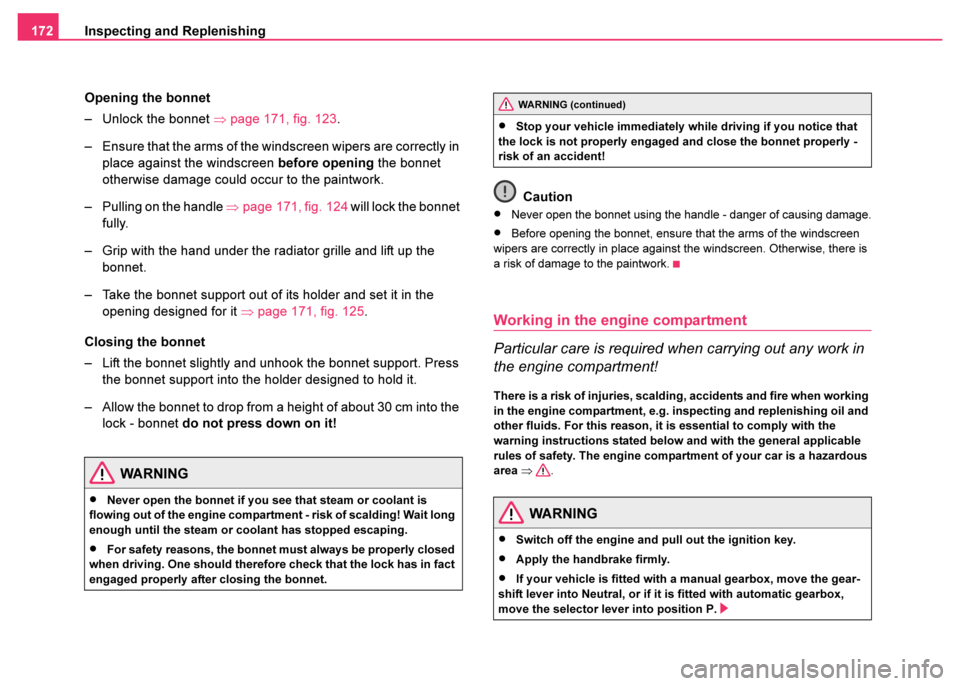
Inspecting and Replenishing
172
Opening the bonnet
– Unlock the bonnet ⇒page 171, fig. 123 .
– Ensure that the arms of the windscreen wipers are correctly in place against the windscreen before opening the bonnet
otherwise damage could occur to the paintwork.
– Pulling on the handle ⇒page 171, fig. 124 will lock the bonnet
fully.
– Grip with the hand under the radiator grille and lift up the bonnet.
– Take the bonnet support out of its holder and set it in the opening designed for it ⇒page 171, fig. 125 .
Closing the bonnet
– Lift the bonnet slightly and unhook the bonnet support. Press the bonnet support into the holder designed to hold it.
– Allow the bonnet to drop from a height of about 30 cm into the lock - bonnet do not press down on it! Caution
•Never open the bonnet using the handle - danger of causing damage.
•Before opening the bonnet, ensure that the arms of the windscreen
wipers are correctly in place against the windscreen. Otherwise, there is
a risk of damage to the paintwork.
Working in the engine compartment
Particular care is required when carrying out any work in
the engine compartment!
There is a risk of injuries, scalding, accidents and fire when working
in the engine compartment, e.g. inspecting and replenishing oil and
other fluids. For this reason, it is essential to comply with the
warning instructions stated below and with the general applicable
rules of safety. The engine compartment of your car is a hazardous
area ⇒ .
WARNING
•Never open the bonnet if you see that steam or coolant is
flowing out of the engine compartment - risk of scalding! Wait long
enough until the steam or coolant has stopped escaping.
•For safety reasons, the bonnet must always be properly closed
when driving. One should therefore check that the lock has in fact
engaged properly after closing the bonnet.
WARNING (continued)
•Stop your vehicle immediately while driving if you notice that
the lock is not properly engaged and close the bonnet properly -
risk of an accident!
WARNING
•Switch off the engine and pull out the ignition key.
•Apply the handbrake firmly.
•If your vehicle is fitted with a manual gearbox, move the gear-
shift lever into Neutral, or if it is fitted with automatic gearbox,
move the selector lever into position P.
Page 174 of 233
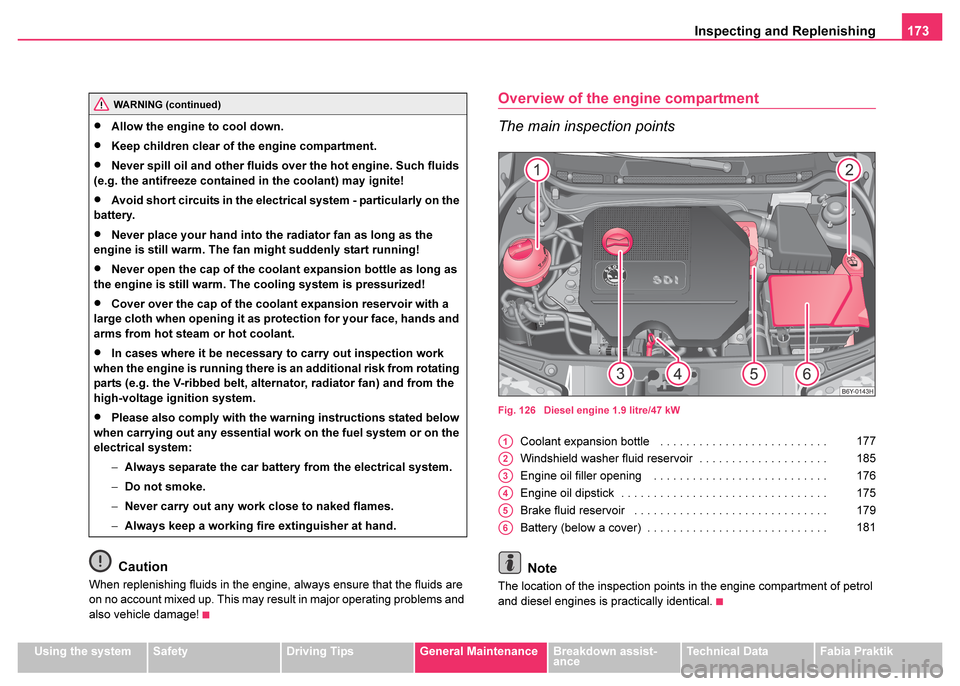
Inspecting and Replenishing173
Using the systemSafetyDriving TipsGeneral MaintenanceBreakdown assist-
anceTechnical DataFabia Praktik
Caution
When replenishing fluids in the engine, always ensure that the fluids are
on no account mixed up. This may result in major operating problems and
also vehicle damage!
Overview of the engine compartment
The main inspection points
Fig. 126 Diesel engine 1.9 litre/47 kW
Coolant expansion bottle . . . . . . . . . . . . . . . . . . . . . . . . . .
Windshield washer fluid reservoir . . . . . . . . . . . . . . . . . . . .
Engine oil filler opening . . . . . . . . . . . . . . . . . . . . . . . . . . .
Engine oil dipstick . . . . . . . . . . . . . . . . . . . . . . . . . . . . . . . .
Brake fluid reservoir . . . . . . . . . . . . . . . . . . . . . . . . . . . . . .
Battery (below a cover) . . . . . . . . . . . . . . . . . . . . . . . . . . . .
Note
The location of the inspection points in the engine compartment of petrol
and diesel engines is practically identical.
WARNING (continued)
•Allow the engine to cool down.
•Keep children clear of the engine compartment.
•Never spill oil and other fluids over the hot engine. Such fluids
(e.g. the antifreeze contained in the coolant) may ignite!
•Avoid short circuits in the electrical system - particularly on the
battery.
•Never place your hand into the radiator fan as long as the
engine is still warm. The fan might suddenly start running!
•Never open the cap of the coolant expansion bottle as long as
the engine is still warm. The cooling system is pressurized!
•Cover over the cap of the coolant expansion reservoir with a
large cloth when opening it as protection for your face, hands and
arms from hot steam or hot coolant.
•In cases where it be necessary to carry out inspection work
when the engine is running there is an additional risk from rotating
parts (e.g. the V-ribbed belt, alternator, radiator fan) and from the
high-voltage ignition system.
•Please also comply with the warning instructions stated below
when carrying out any essential work on the fuel system or on the
electrical system:
−Always separate the car battery from the electrical system.
− Do not smoke.
− Never carry out any work close to naked flames.
− Always keep a working fire extinguisher at hand.
A1177
A2185
A3176
A4175
A5179
A6181
Page 175 of 233
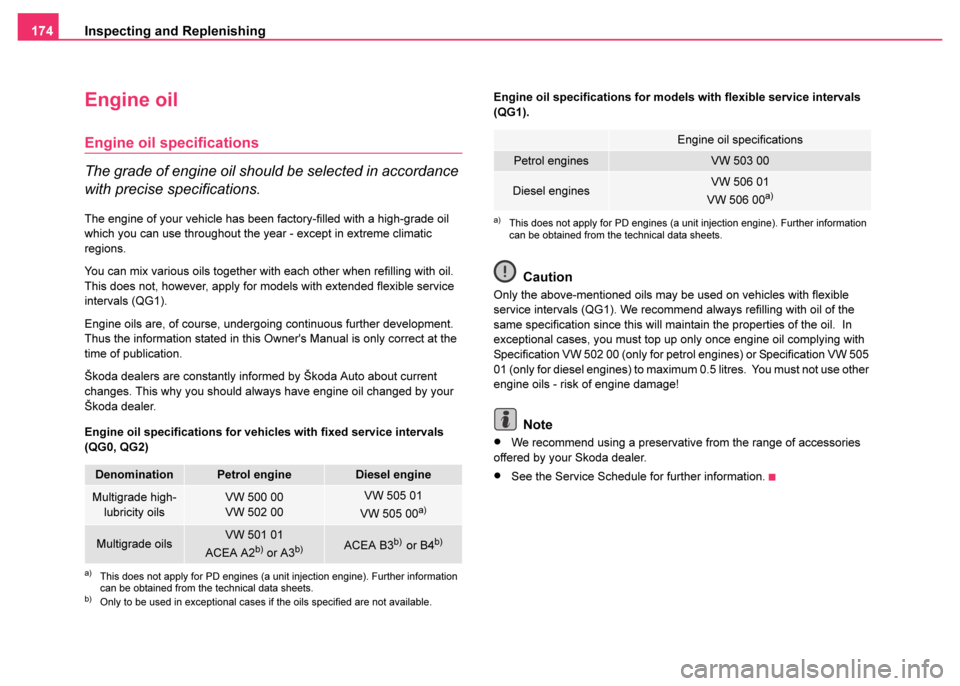
Inspecting and Replenishing
174
Engine oil
Engine oil specifications
The grade of engine oil should be selected in accordance
with precise specifications.
The engine of your vehicle has been factory-filled with a high-grade oil
which you can use throughout the year - except in extreme climatic
regions.
You can mix various oils together with each other when refilling with oil.
This does not, however, apply for models with extended flexible service
intervals (QG1).
Engine oils are, of course, undergoing continuous further development.
Thus the information stated in this Owner's Manual is only correct at the
time of publication.
Škoda dealers are constantly informed by Škoda Auto about current
changes. This why you should always have engine oil changed by your
Škoda dealer.
Engine oil specifications for vehicles with fixed service intervals
(QG0, QG2) Engine oil specifications for models with flexible service intervals
(QG1).
Caution
Only the above-mentioned oils may be used on vehicles with flexible
service intervals (QG1). We recommend always refilling with oil of the
same specification since this will maintain the properties of the oil. In
exceptional cases, you must top up only once engine oil complying with
Specification VW 502 00 (only for petrol engines) or Specification VW 505
01 (only for diesel engines) to maximum 0.5 litres. You must not use other
engine oils - risk of engine damage!
Note
•We recommend using a preservative from the range of accessories
offered by your Skoda dealer.
•See the Service Schedule for further information.DenominationPetrol engineDiesel engine
Multigrade high- lubricity oilsVW 500 00
VW 502 00VW 505 01
VW 505 00a)
a)This does not apply for PD engines (a unit injection engine). Further information
can be obtained from the technical data sheets.
Multigrade oilsVW 501 01
ACEA A2b) or A3b)
b)Only to be used in exceptional cases if the oils specified are not available.
ACEA B3b) or B4b)
Engine oil specifications
Petrol enginesVW 503 00
Diesel enginesVW 506 01
VW 506 00a)
a)This does not apply for PD engines (a unit injection engine). Further information
can be obtained from the technical data sheets.
Page 176 of 233
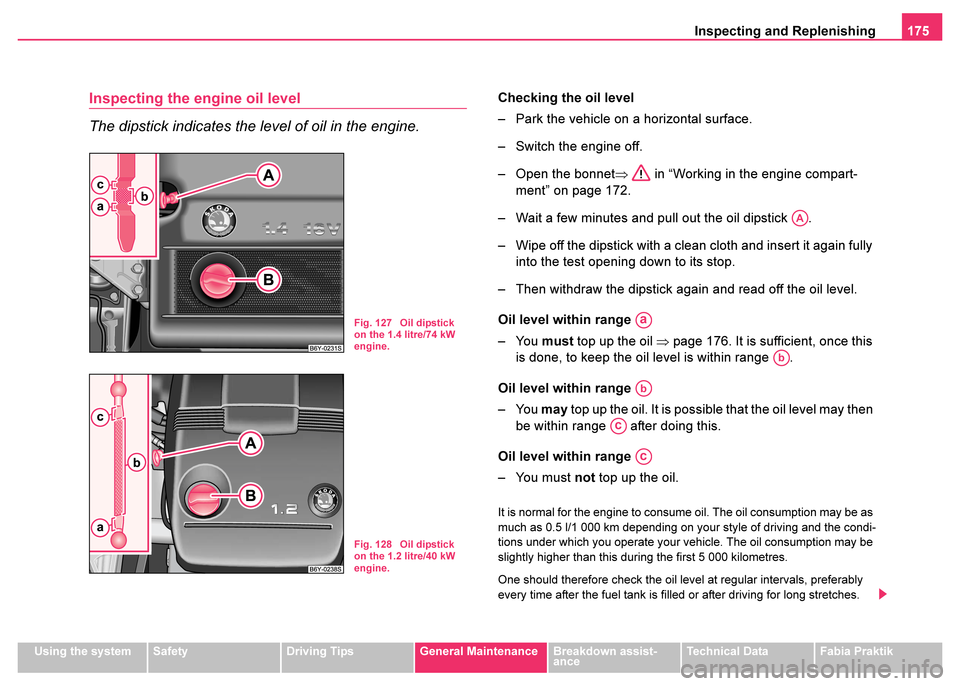
Inspecting and Replenishing175
Using the systemSafetyDriving TipsGeneral MaintenanceBreakdown assist-
anceTechnical DataFabia Praktik
Inspecting the engine oil level
The dipstick indicates the level of oil in the engine.Checking the oil level
– Park the vehicle on a horizontal surface.
– Switch the engine off.
– Open the bonnet⇒ in “Working in the engine compart-
ment” on page 172.
– Wait a few mi nutes and pull out the oil dipstick .
– Wipe off the dipstick wi th a clean cloth and insert it again fully
into the test opening down to its stop.
– Then withdraw the dipstick again and read off the oil level.
Oil level within range
– You must top up the oil ⇒page 176. It is sufficient, once this
is done, to keep the oil level is within range .
Oil level within range
– You may top up the oil. It is possible that the oil level may then
be within range after doing this.
Oil level within range
– You must not top up the oil.
It is normal for the engine to consume oil. The oil consumption may be as
much as 0.5 l/1 000 km depending on your style of driving and the condi-
tions under which you operate your vehicle. The oil consumption may be
slightly higher than this during the first 5 000 kilometres.
One should therefore check the oil level at regular intervals, preferably
every time after the fuel tank is filled or after driving for long stretches.
Fig. 127 Oil dipstick
on the 1.4 litre/74 kW
engine.
Fig. 128 Oil dipstick
on the 1.2 litre/40 kW
engine.
AA
Aa
Ab
Ab
Ac
Ac
Page 177 of 233
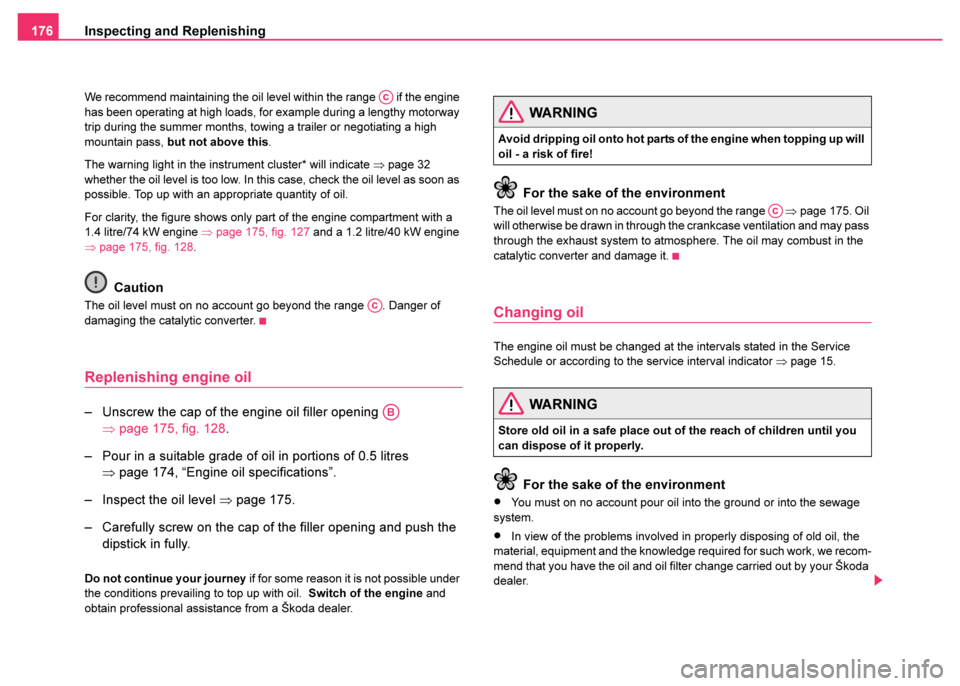
Inspecting and Replenishing
176
We recommend maintaining the oil level within the range if the engine
has been operating at high loads, for example during a lengthy motorway
trip during the summer months, towing a trailer or negotiating a high
mountain pass, but not above this .
The warning light in the instrument cluster* will indicate ⇒page 32
whether the oil level is too low. In this case, check the oil level as soon as
possible. Top up with an appropriate quantity of oil.
For clarity, the figure shows only part of the engine compartment with a
1.4 litre/74 kW engine ⇒page 175, fig. 127 and a 1.2 litre/40 kW engine
⇒ page 175, fig. 128.
Caution
The oil level must on no account go beyond the range . Danger of
damaging the catalytic converter.
Replenishing engine oil
– Unscrew the cap of the engine oil filler opening
⇒page 175, fig. 128 .
– Pour in a suitable grade of oil in portions of 0.5 litres ⇒page 174, “Engine oil specifications”.
– Inspect the oil level ⇒page 175.
– Carefully screw on the cap of the filler opening and push the dipstick in fully.
Do not continue your journey if for some reason it is not possible under
the conditions prevailing to top up with oil. Switch of the engine and
obtain professional assistance from a Škoda dealer.
For the sake of the environment
The oil level must on no account go beyond the range ⇒page 175. Oil
will otherwise be drawn in through the crankcase ventilation and may pass
through the exhaust system to atmosphere. The oil may combust in the
catalytic converter and damage it.
Changing oil
The engine oil must be changed at the intervals stated in the Service
Schedule or according to the service interval indicator ⇒page 15.
For the sake of the environment
•You must on no account pour oil into the ground or into the sewage
system.
•In view of the problems involved in properly disposing of old oil, the
material, equipment and the knowledge required for such work, we recom-
mend that you have the oil and oil filter change carried out by your Škoda
dealer.
Ac
Ac
AB
WARNING
Avoid dripping oil onto hot parts of the engine when topping up will
oil - a risk of fire!
WARNING
Store old oil in a safe place out of the reach of children until you
can dispose of it properly.
Ac
Page 178 of 233

Inspecting and Replenishing177
Using the systemSafetyDriving TipsGeneral MaintenanceBreakdown assist-
anceTechnical DataFabia Praktik
Note
You must not pour any additives into the oil - risk of engine damage!
Cooling system
Coolant
The job of the coolant is to cool the engine.
The cooling system does not require any maintenance under normal oper-
ating conditions. The coolant consists of water with a concentration of
antifreeze agent of 40 %. This mixture not only provides antifreeze protec-
tion down to - 25 °C but also protects the cooling and heating system from
corrosion. It also prevents the formation of scale and significantly
increases the boiling point of the coolant.
You must therefore not reduce the concentration of antifreeze agent in the
coolant by adding water, also not during the summer months or in coun-
tries with a warm climate. The concentration of antifreeze agent in the
coolant must be at least 40%.
You can increase the amount of antifreeze in the coolant iIf a higher
concentration of antifreeze is necessary for climatic reasons but only up
to 60% (antifreeze protection down to approx. -40°C). The antifreeze
protection tails off above that concentration.
Vehicles exported to countries with a cold climate (e.g. Sweden, Norway,
Finland) are already factory-filled with a coolant which offers antifreeze
protection down to about -35°C.
Coolant
The cooling system is factory-filled with TL 774-F (G12 PLUS) coolant,
which is purple in colour. We recommend that you use the same antifreeze agent - G12 PLUS
(purple in colour).
Please contact your Škoda dealer if you have any questions regarding the
coolant or if you wish to fill up with a different coolant.
Your Škoda dealer can also supply you with the correct coolant additives.
Caution
•Other coolant additives may cause operational problems which,
in particular, involves significantly reducing the anticorrosion effect.
•Any faults or problems resulting from corrosion may cause a loss
of coolant and, as a consequence of this, result in major engine
damage.
Inspecting the coolant level
Fig. 129 Engine
compartment: Coolant
expansion bottle
Page 179 of 233
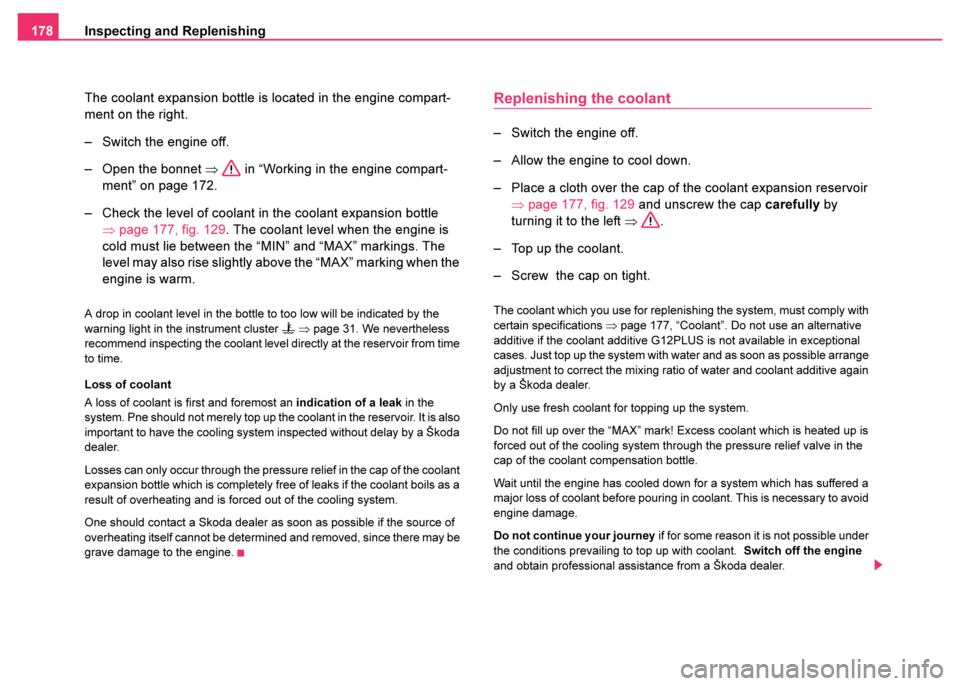
Inspecting and Replenishing
178
The coolant expansion bottle is located in the engine compart-
ment on the right.
– Switch the engine off.
– Open the bonnet ⇒ in “Working in the engine compart-
ment” on page 172.
– Check the level of coolant in the coolant expansion bottle ⇒page 177, fig. 129 . The coolant level when the engine is
cold must lie between the “MIN” and “MAX” markings. The
level may also rise slightly above the “MAX” marking when the
engine is warm.
A drop in coolant level in the bottle to too low will be indicated by the
warning light in the instrument cluster ⇒ page 31. We nevertheless
recommend inspecting the coolant level directly at the reservoir from time
to time.
Loss of coolant
A loss of coolant is first and foremost an indication of a leak in the
system. Pne should not merely top up the coolant in the reservoir. It is also
important to have the cooling system inspected without delay by a Škoda
dealer.
Losses can only occur through the pressure relief in the cap of the coolant
expansion bottle which is completely free of leaks if the coolant boils as a
result of overheating and is forced out of the cooling system.
One should contact a Skoda dealer as soon as possible if the source of
overheating itself cannot be determined and removed, since there may be
grave damage to the engine.
Replenishing the coolant
– Switch the engine off.
– Allow the engine to cool down.
– Place a cloth over the cap of the coolant expansion reservoir ⇒page 177, fig. 129 and unscrew the cap carefully by
turning it to the left ⇒.
– Top up the coolant.
– Screw the cap on tight.
The coolant which you use for replenishing the system, must comply with
certain specifications ⇒page 177, “Coolant”. Do not use an alternative
additive if the coolant additive G12PLUS is not available in exceptional
cases. Just top up the system with water and as soon as possible arrange
adjustment to correct the mixing ratio of water and coolant additive again
by a Škoda dealer.
Only use fresh coolant for topping up the system.
Do not fill up over the “MAX” mark! Excess coolant which is heated up is
forced out of the cooling system through the pressure relief valve in the
cap of the coolant compensation bottle.
Wait until the engine has cooled down for a system which has suffered a
major loss of coolant before pouring in coolant. This is necessary to avoid
engine damage.
Do not continue your journey if for some reason it is not possible under
the conditions prevailing to top up with coolant. Switch off the engine
and obtain professional assistance from a Škoda dealer.
Page 180 of 233
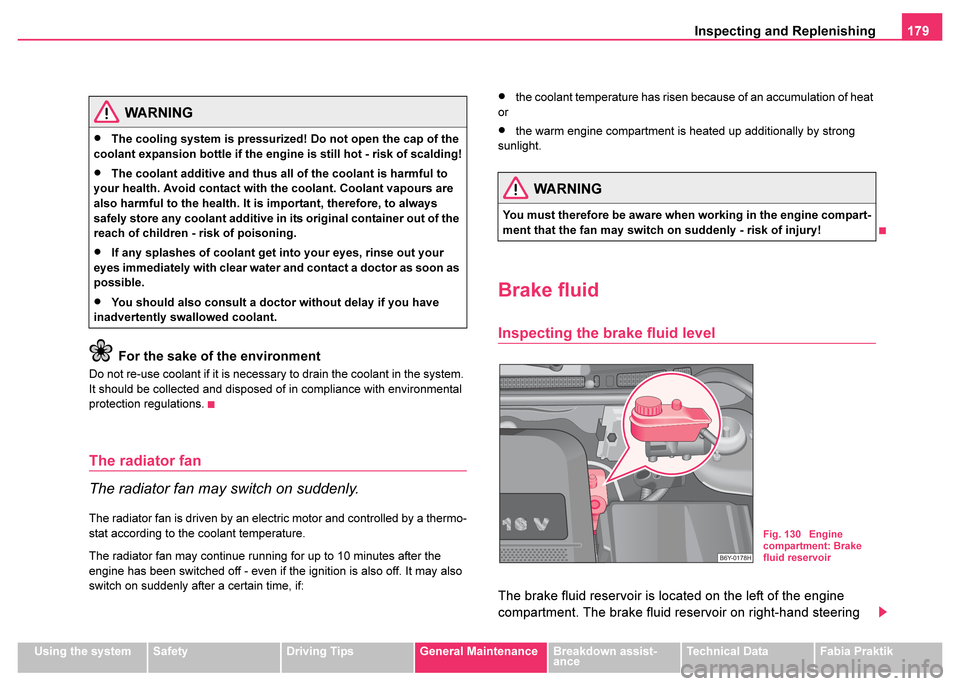
Inspecting and Replenishing179
Using the systemSafetyDriving TipsGeneral MaintenanceBreakdown assist-
anceTechnical DataFabia Praktik
For the sake of the environment
Do not re-use coolant if it is necessary to drain the coolant in the system.
It should be collected and disposed of in compliance with environmental
protection regulations.
The radiator fan
The radiator fan may switch on suddenly.
The radiator fan is driven by an electric motor and controlled by a thermo-
stat according to the coolant temperature.
The radiator fan may continue running for up to 10 minutes after the
engine has been switched off - even if the ignition is also off. It may also
switch on suddenly after a certain time, if:
•the coolant temperature has risen because of an accumulation of heat
or
•the warm engine compartment is heated up additionally by strong
sunlight.
Brake fluid
Inspecting the brake fluid level
The brake fluid reservoir is located on the left of the engine
compartment. The brake fluid reservoir on right-hand steering
WARNING
•The cooling system is pressurized! Do not open the cap of the
coolant expansion bottle if the engine is still hot - risk of scalding!
•The coolant additive and thus all of the coolant is harmful to
your health. Avoid contact with the coolant. Coolant vapours are
also harmful to the health. It is important, therefore, to always
safely store any coolant additive in its original container out of the
reach of children - risk of poisoning.
•If any splashes of coolant get into your eyes, rinse out your
eyes immediately with clear water and contact a doctor as soon as
possible.
•You should also consult a doctor without delay if you have
inadvertently swallowed coolant.
WARNING
You must therefore be aware when working in the engine compart-
ment that the fan may switch on suddenly - risk of injury!
Fig. 130 Engine
compartment: Brake
fluid reservoir